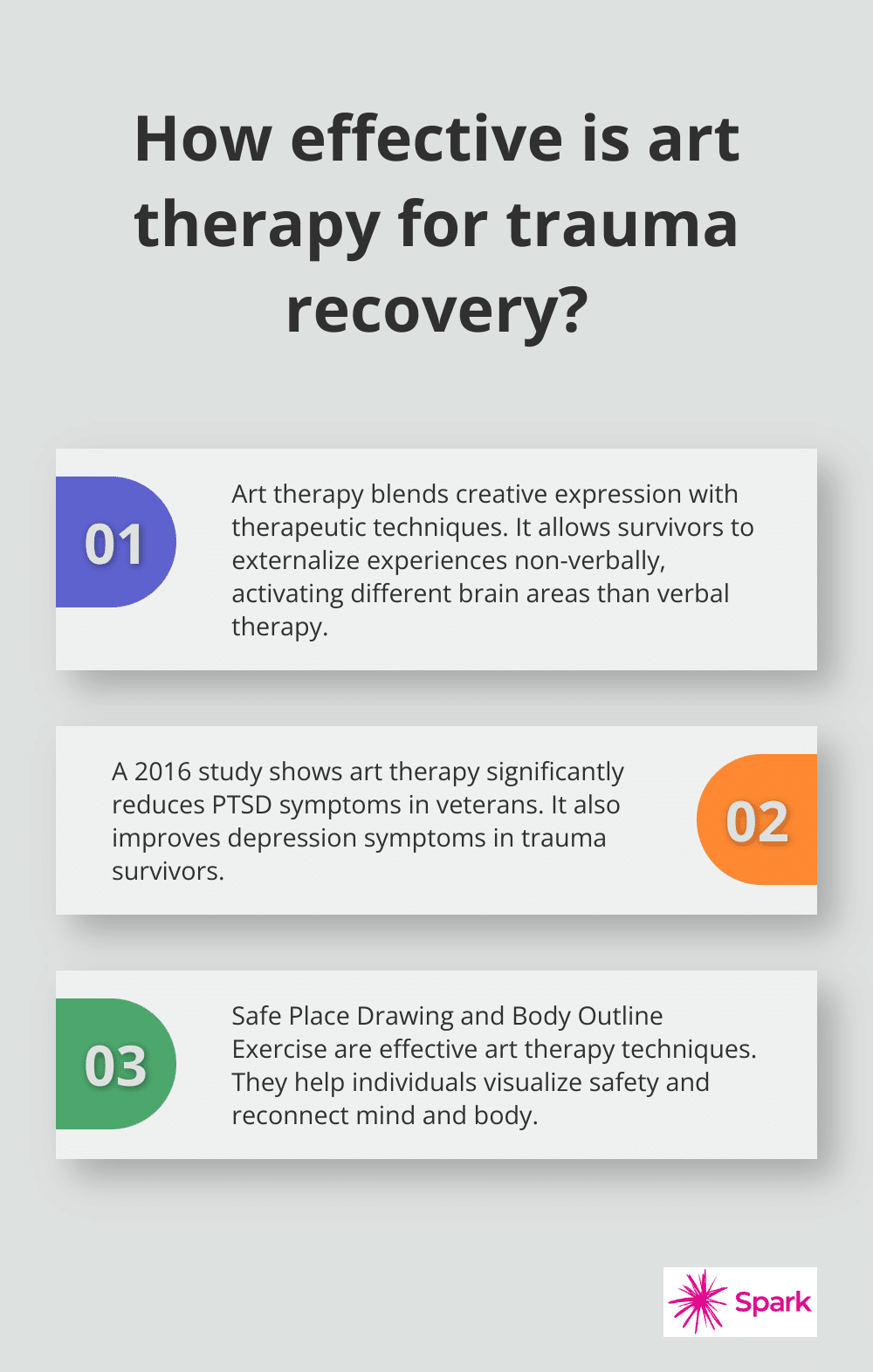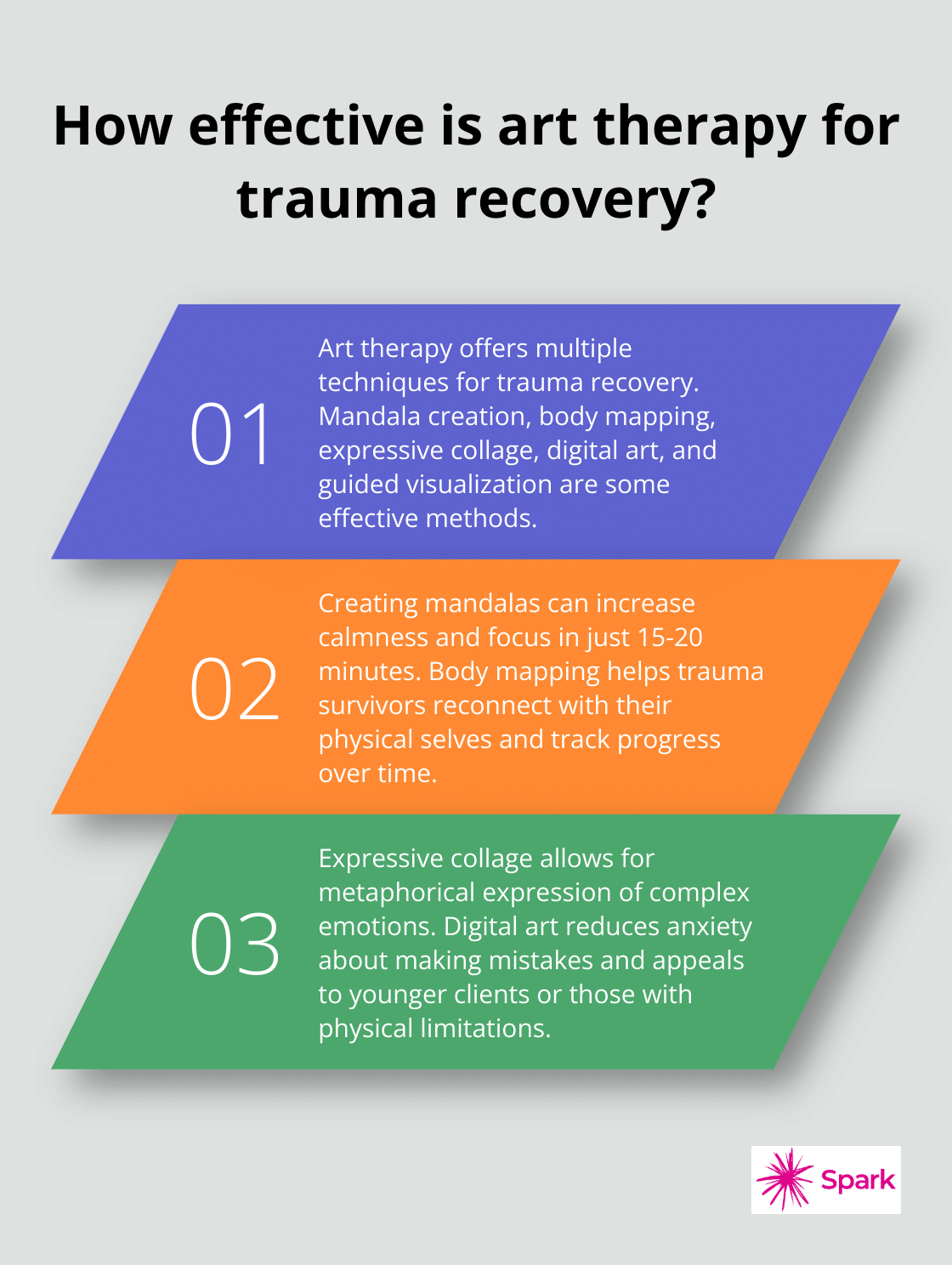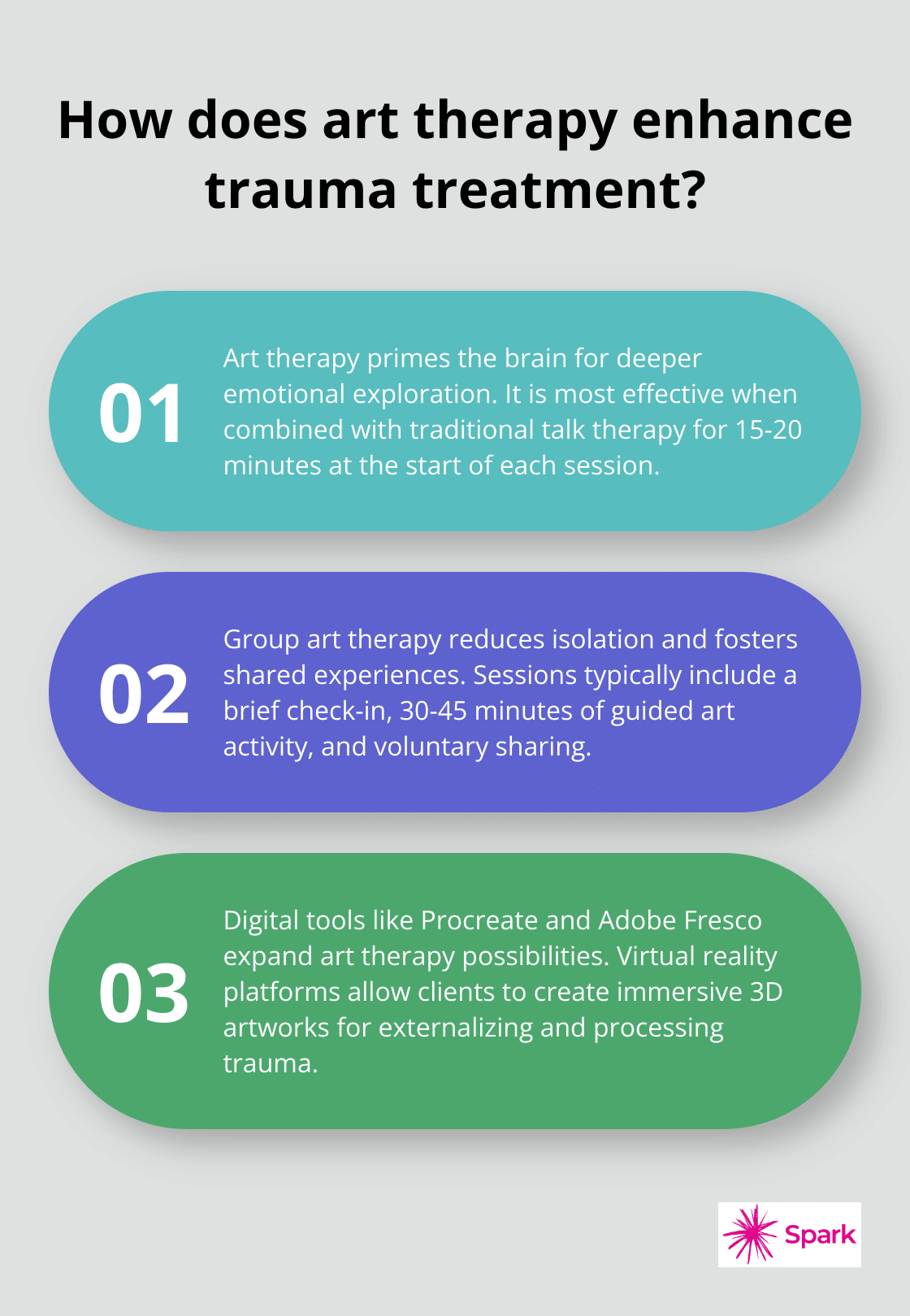Art therapy offers a powerful avenue for healing trauma through creative expression. At Spark Mental Health, we’ve seen firsthand how trauma art therapy ideas can help survivors process difficult emotions and experiences.
This blog post explores various art therapy techniques and activities specifically designed for trauma recovery. We’ll also discuss how to integrate these methods into comprehensive treatment plans, empowering individuals on their journey to healing.
Unlocking Healing Through Art Therapy
The Power of Creative Expression
Art therapy stands as a potent tool for trauma recovery, blending creative expression with therapeutic techniques. This approach allows survivors to externalize their experiences, emotions, and memories in a safe, non-verbal manner. The process activates different parts of the brain than those typically engaged during verbal therapy, which can help process traumatic memories and emotions that might be difficult to articulate.
Scientific Backing for Art Therapy
Research supports the effectiveness of art therapy in trauma treatment. A study published in 2016 demonstrates that art therapy significantly reduces PTSD symptoms in veterans, improving depression and PTSD symptoms. These findings underscore the potential of creative interventions in addressing complex psychological issues.
Effective Art Therapy Techniques
Safe Place Drawing
This exercise encourages individuals to visualize and create an image of a place where they feel completely secure. The process itself can be deeply calming and grounding, providing a tangible representation of safety.
Body Outline Exercise
Participants trace their body on a large piece of paper and then fill it with colors, symbols, or words representing their emotions and physical sensations. This technique helps reconnect mind and body, often disrupted by trauma.
Integrating Art Therapy into Treatment Plans
Art therapy yields the best results when integrated into a comprehensive treatment plan. Many mental health professionals combine art therapy with other evidence-based approaches like cognitive-behavioral therapy (CBT) or eye movement desensitization and reprocessing (EMDR).

Group art therapy sessions can also prove particularly powerful. They provide a sense of community and shared experience, reducing the isolation often felt by trauma survivors. A study in 2014 highlighted the potential benefits of group art therapy in reducing depression among women who experienced domestic violence.
It’s important to note that art therapy doesn’t require artistic skill – the focus lies on the process of creation and expression. Whether through painting, sculpting, or digital art, the goal remains to provide a safe outlet for processing trauma and fostering healing.
As we move forward, we’ll explore specific art therapy activities designed to support trauma survivors in their healing journey. These practical exercises offer concrete ways to apply the principles of art therapy in both individual and group settings.
Practical Art Therapy Exercises for Trauma Recovery
Creating Mandalas for Inner Peace
Mandala creation serves as a powerful centering technique. To begin, draw a circular outline on paper. Fill the circle with patterns, shapes, and colors that resonate with you using colored pencils, markers, or paint. There’s no correct way to create a mandala – the process itself holds the value.

Many individuals report increased calmness and focus after dedicating just 15-20 minutes to this exercise. The repetitive, symmetrical nature of mandalas can quiet racing thoughts and reduce anxiety. Try creating a mandala when you feel overwhelmed or before bedtime to promote relaxation.
Body Mapping: Reconnecting Mind and Body
Body mapping helps trauma survivors reconnect with their physical selves. Lie down on a large piece of paper and have someone trace your body outline. Use art materials to fill in the outline, representing your emotions, sensations, and experiences.
You might use red to show areas of tension, blue for calm spots, or add symbols and words that represent your feelings. This visual representation can provide insights into how trauma affects you physically and emotionally. It also serves as a great tool for tracking progress over time – create a new body map every few months to observe changes in your self-perception.
Expressive Collage: Giving Form to Complex Emotions
Collage-making offers an excellent way to express complex emotions that might challenge verbal articulation. Gather old magazines, newspapers, and personal photos. Cut out images, words, and textures that speak to your experiences or feelings. Arrange and glue these elements onto a canvas or sturdy paper.
The beauty of collage lies in its allowance for metaphorical expression. For example, a client once used an image of a stormy sea to represent turbulent emotions, alongside pictures of sunlight breaking through clouds to symbolize hope. This technique can help externalize difficult feelings and create a visual narrative of your healing journey.
Digital Art: Embracing Technology in Therapy
In today’s digital age, art therapy has expanded to include digital mediums. Using tablets or computers, clients can create digital paintings, photo manipulations, or even 3D sculptures. This approach proves particularly appealing to younger clients or those with physical limitations that might make traditional art materials challenging.
Digital art offers unique advantages, such as the ability to easily undo or modify elements, which can reduce anxiety about “making mistakes.” It also allows for seamless integration of personal photos or meaningful imagery found online, enhancing the personal relevance of the artwork.
Guided Visualization and Art
This technique combines the power of guided imagery with artistic expression. A therapist leads the client through a calming visualization exercise, often focused on a safe or peaceful place. After the visualization, the client creates artwork based on their experience.
Art therapy can be particularly effective when combined with traditional talk therapy, as it enhances the therapeutic process. The resulting artwork often serves as a powerful tool for further discussion and insight in therapy sessions.
As we explore these art therapy techniques, it’s important to consider how they can be integrated into a comprehensive treatment plan. The next section will discuss strategies for combining art therapy with other therapeutic approaches to maximize its benefits for trauma recovery.
How to Integrate Art Therapy into Trauma Treatment
Art therapy is a powerful tool for trauma recovery, but its effectiveness multiplies when integrated strategically into a comprehensive treatment plan. Here’s how to make the most of art therapy in trauma treatment:
Blending Art and Talk Therapy
The combination of art therapy with traditional talk therapy creates a synergistic effect. Start each session with 15-20 minutes of art creation. This primes the brain for deeper emotional exploration and often surfaces subconscious thoughts. Follow the art-making with a discussion about the piece, using it as a springboard for further therapeutic dialogue.

For example, a client struggling with anxiety created a chaotic abstract painting dominated by dark colors. This led to a breakthrough conversation about feeling overwhelmed and out of control, which might not have emerged as quickly through talk therapy alone.
Maximizing Group Art Therapy
Group art therapy sessions offer unique benefits for trauma survivors. They reduce isolation and foster a sense of shared experience. When you facilitate group sessions, start with a brief check-in, followed by a guided art activity. Allow 30-45 minutes for creation, then encourage voluntary sharing.
One effective group exercise is the creation of a collective mural. Each participant contributes to a large shared canvas, representing their trauma recovery journey. This visual representation of collective healing can be incredibly powerful.
Harnessing Digital Tools
Digital art tools open new possibilities for art therapy, especially for tech-savvy clients or those with physical limitations. Incorporate apps like Procreate or Adobe Fresco into sessions. These tools offer features like layers and easy undoing, reducing anxiety about “mistakes.”
One innovative approach is the use of virtual reality (VR) for art therapy. VR platforms allow clients to create immersive 3D artworks, providing a unique way to externalize and process trauma.
Personalizing the Approach
When you integrate these approaches, always prioritize the client’s comfort and preferences. Some may prefer traditional materials, while others thrive with digital tools. The key is flexibility and personalization in your approach.
Art therapy is most effective as part of a holistic treatment plan. Try to combine it with other evidence-based therapies (such as cognitive-behavioral therapy or eye movement desensitization and reprocessing) for a well-rounded approach to trauma recovery.
Final Thoughts
Art therapy provides powerful tools for trauma recovery. Through creative expression, individuals process complex emotions and find new ways to communicate their experiences. The trauma art therapy ideas we explored offer tangible methods for healing, from mandala creation to body mapping and digital art techniques.

Trauma recovery remains a personal process, and what works for one person may not be as effective for another. Professional guidance proves essential, as a trained art therapist can tailor these techniques to specific needs and integrate them into a comprehensive treatment plan. At Spark Mental Health, we recognize the transformative potential of innovative therapies in trauma recovery.
Our team of mental health professionals dedicates itself to providing personalized, evidence-based care for conditions including PTSD and trauma-related disorders. We offer telepsychiatry services that combine traditional therapeutic approaches with cutting-edge techniques. If you consider exploring art therapy as part of your healing journey, we encourage you to reach out to Spark Mental Health for a free initial assessment.






